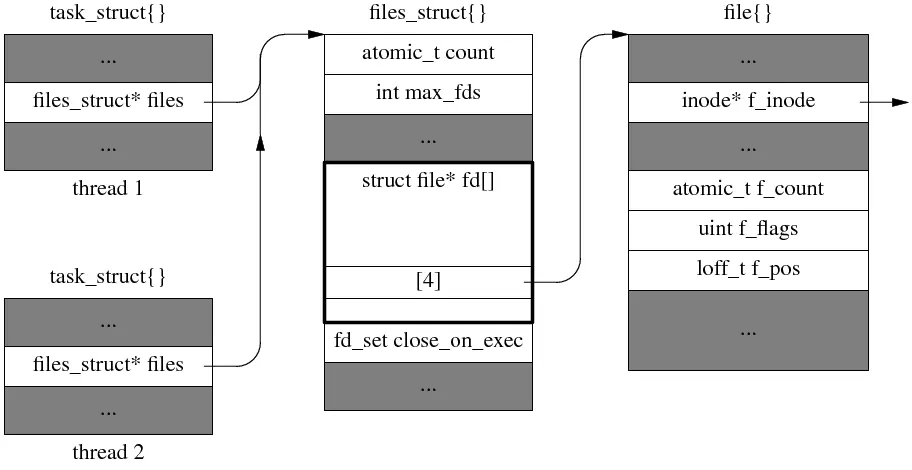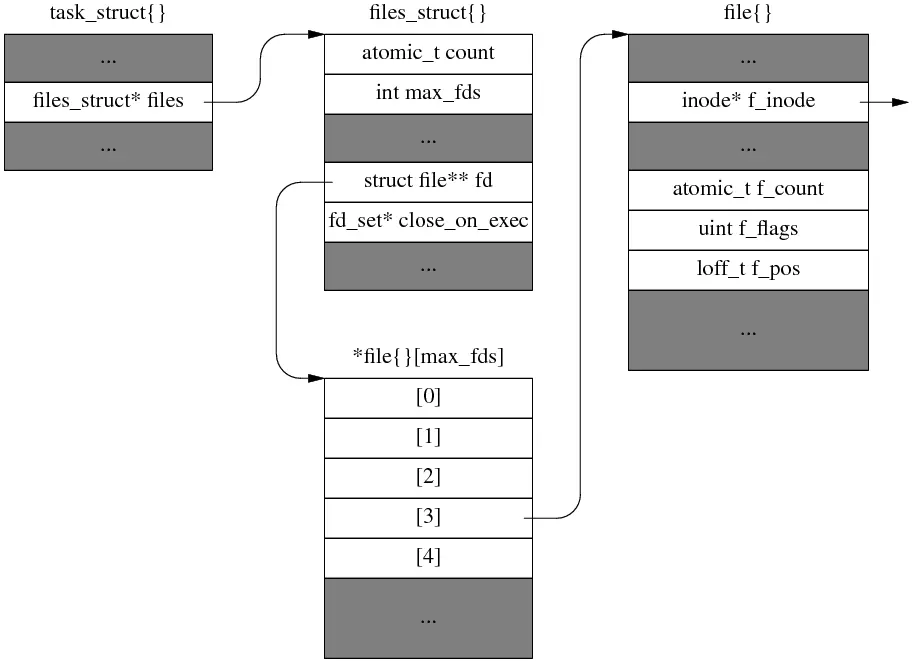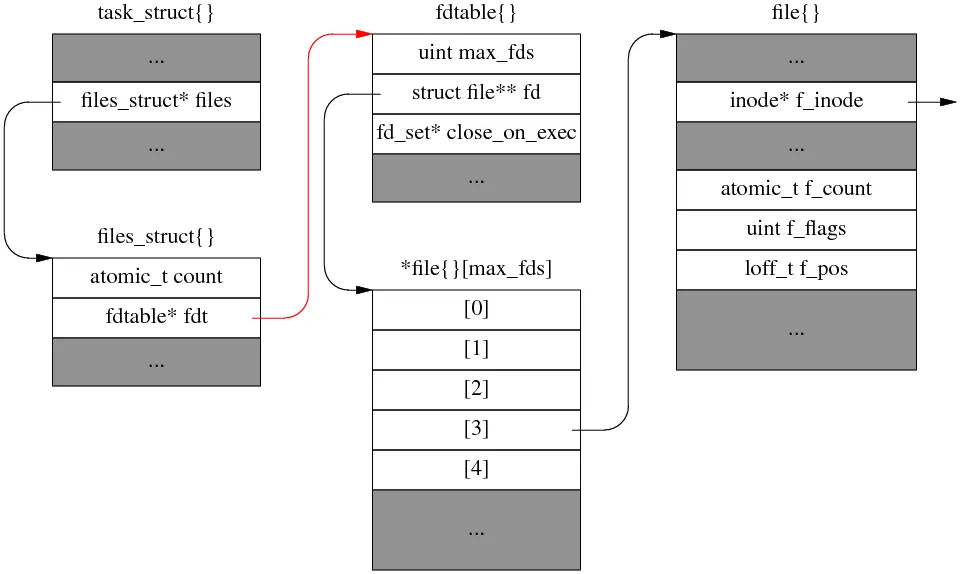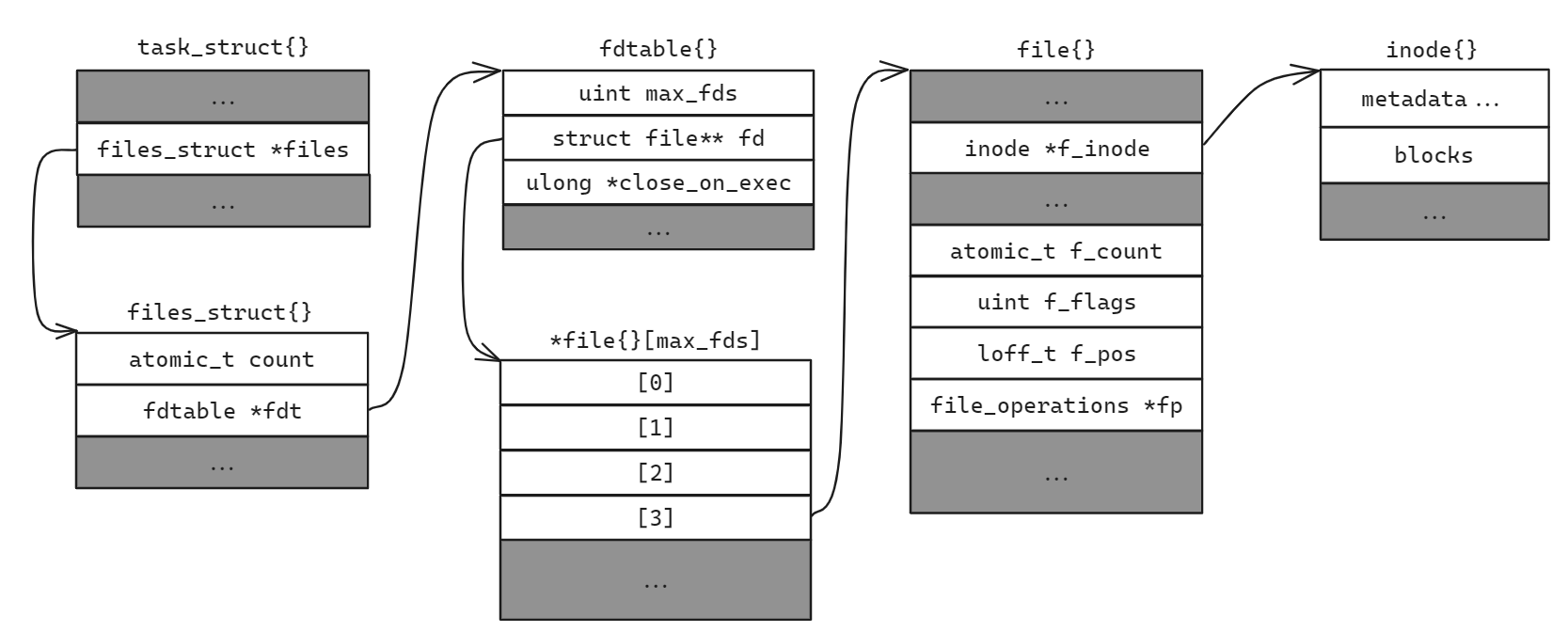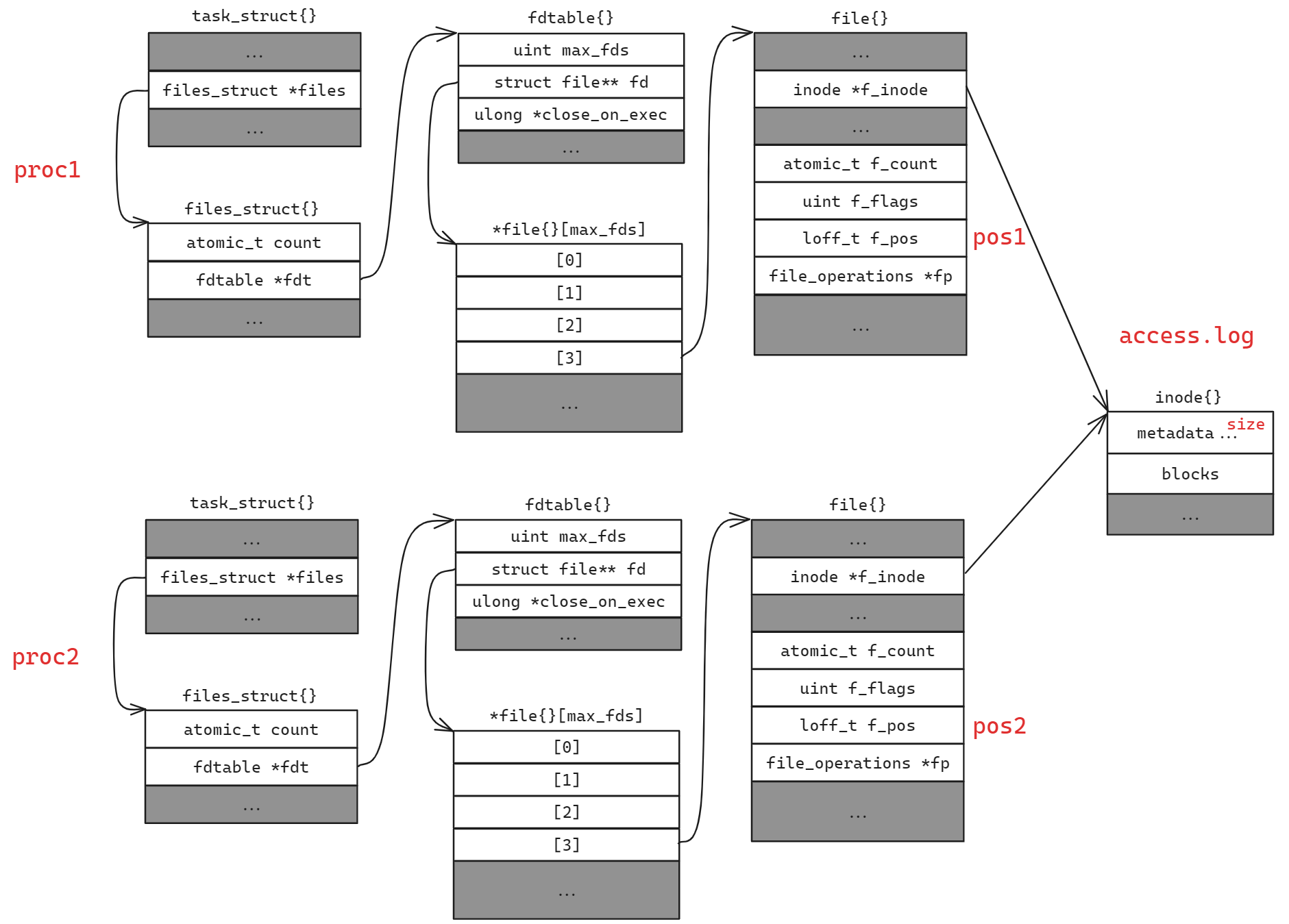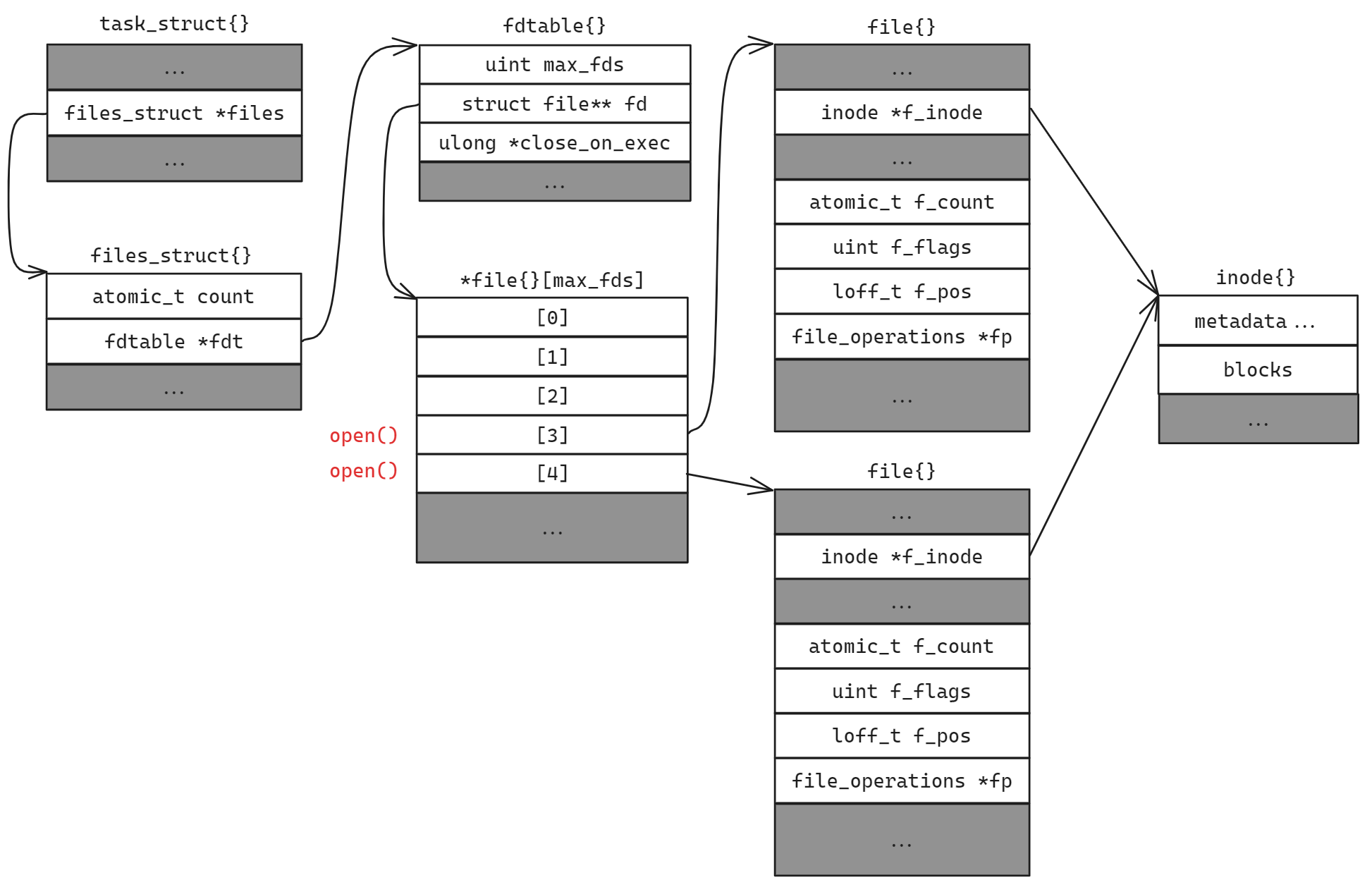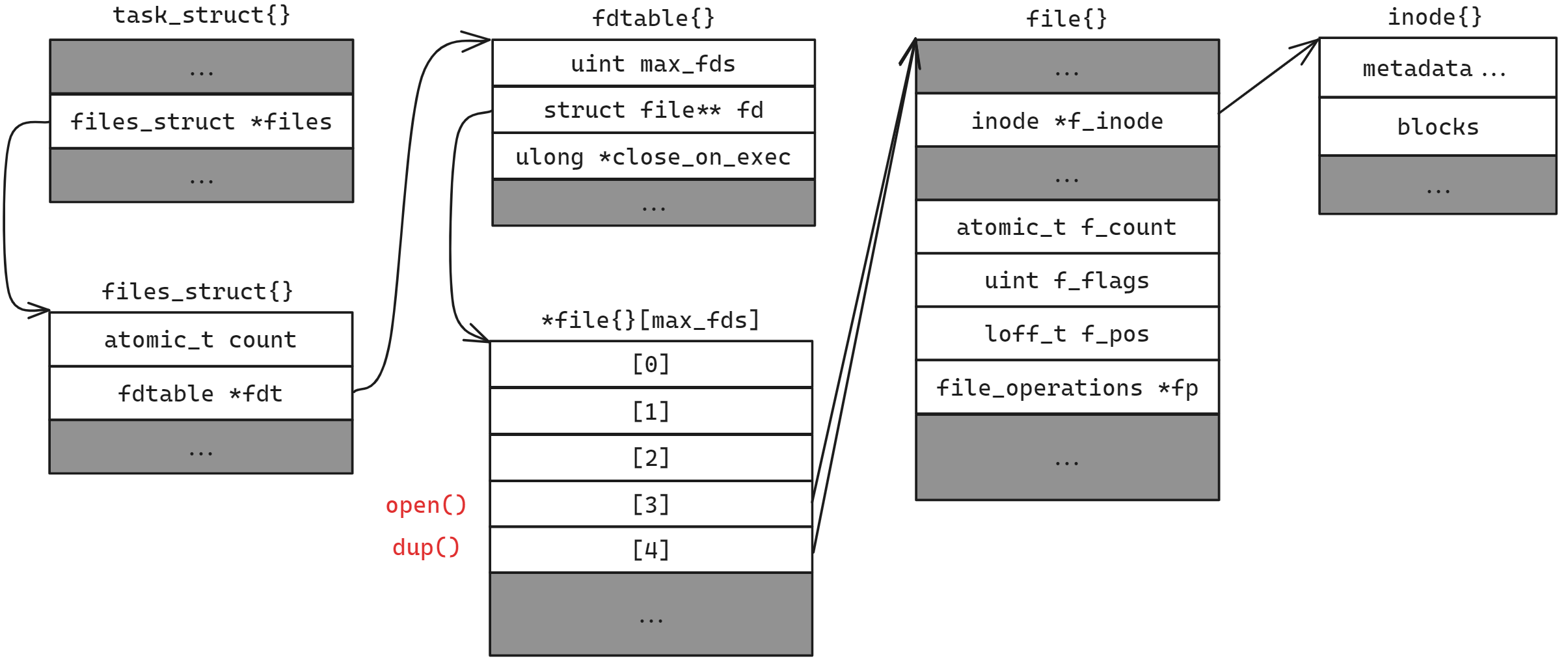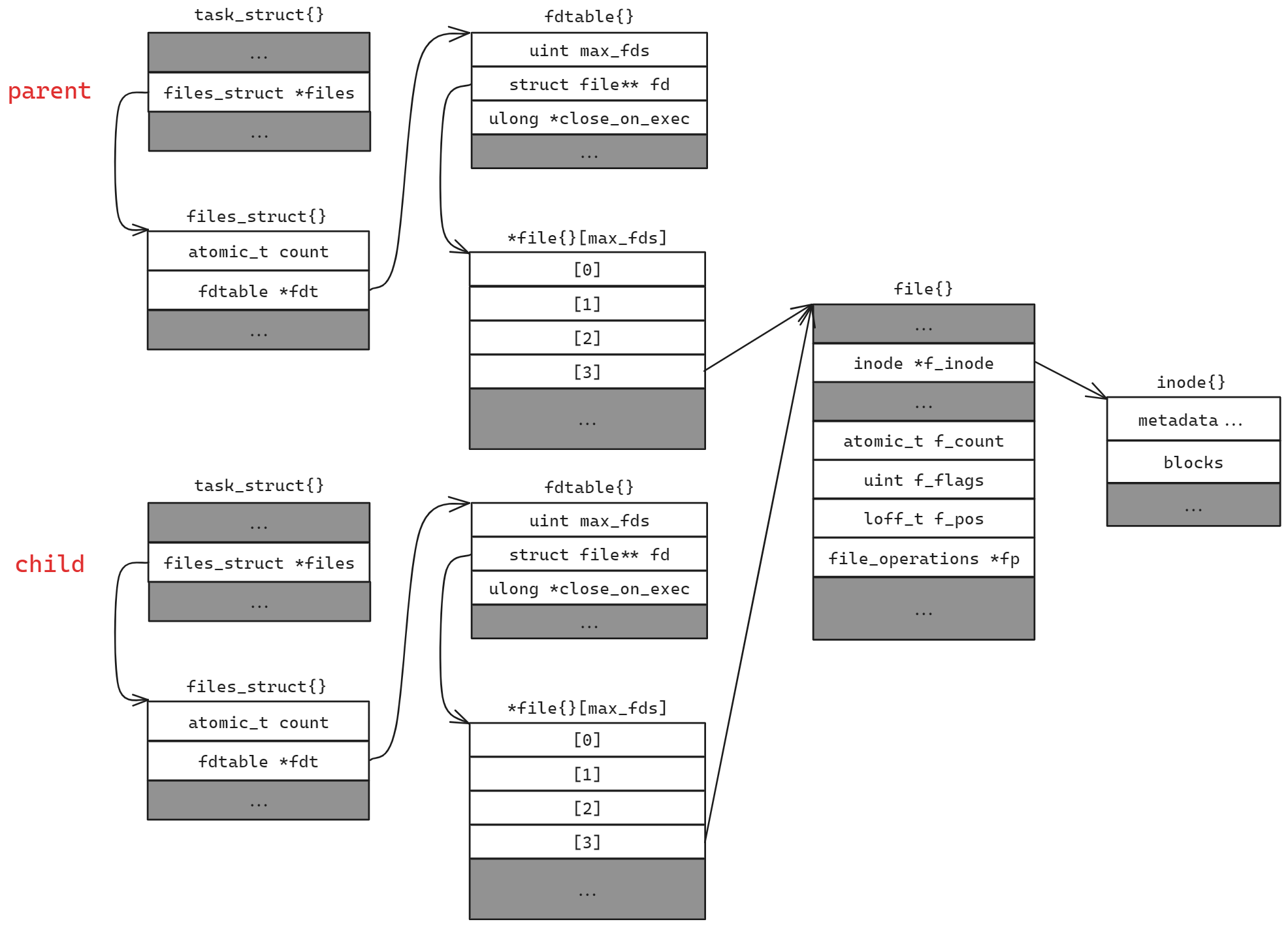fd
在Linux内核中,struct task_struct、struct file和struct inode是三个核心的数据结构,它们共同维护着进程、打开的文件以及文件本身的信息 .
struct task_struct: 这个结构体用于表示系统中的每一个进程和线程。它包含了进程的多种信息,例如进程的状态、调度信息、内存信息、以及文件描述符等。在 task_struct 一节中比较详细的介绍了相关的结构体字段
struct file: 当一个文件在Linux系统中被打开时,会创建一个struct file对象。这个对象包含了特定于打开文件的信息,如文件的偏移量(offset).不同的进程或线程打开同一个文件时,会有不同的struct file对象,因为每个打开的文件都有自己的偏移量和文件状态.
struct inode: 表示文件系统中的一个文件或目录。它存储了文件的元数据,如文件大小、权限、时间戳(创建时间、修改时间等).一个struct inode对象对应于文件系统中的一个唯一文件或目录,即使该文件被多次打开,所有相关的struct file对象都会指向同一个struct inode对象。
简而言之, struct file 和 struct inode 的区别和联系主要在于:
- 文件偏移量:每个
struct file对象都有自己的偏移量,表示该文件在进程中的读取/写入位置。例如,一个web服务器可能从文件末尾追加日志,而用户使用less查看同一个日志文件时,可能从文件开头开始读取。
- 文件元数据:文件的元数据,如长度、权限等,存储在
struct inode中。这意味着,即使多个进程打开了同一个文件,它们看到的文件属性(如通过ls -l或stat(2)系统调用获取的)都是一致的。
fd 的演进
版本 A:从 0.01 到 1.1.10
最早的 Linux 内核直接把元素为 struct file* 的定长数组放在 struct task_struct 里
// include/linux/sched.h of linux-1.1.10
struct task_struct {
// ...
struct file * filp[NR_OPEN];
fd_set close_on_exec;
// ...
};从 int fd 取到 struct file* fp 的写法是:
struct file* fp = current->filp[fd];而 struct file 和 struct inode 也是位于各自的定长数组中
// fs/file_table.c of linux-0.99
struct file file_table[NR_FILE];
// fs/inode.c of linux-0.99
static struct inode inode_table[NR_INODE];NR_OPEN、NR_FILE、NR_INODE 这几个宏的值决定了上述数组的大小,它们的值逐渐增大。修改 NR_OPEN 会影响 sizeof (struct task_struct),也会直接影响每个进程占用的物理内存的大小,因为 task_struct 对象是不会 swap to disk 的
在 0.99.10 中,struct file 和 struct inode 改成了动态分配,这样整个系统能同时打开的文件数大大增加,但每个进程能打开的文件数还是 NR_OPEN
// fs/file_table.c of linux-0.99.10
-struct file file_table[NR_FILE];
+struct file * first_file;版本 B:1.1.11 到 1.3.21
// include/linux/sched.h of linux-1.3.21
/* Open file table structure */
struct files_struct {
int count;
fd_set close_on_exec;
struct file * fd[NR_OPEN];
};
struct task_struct {
// ...
/* filesystem information */
struct fs_struct fs[1];
/* open file information */
struct files_struct files[1];
/* memory management info */
struct mm_struct mm[1];
// ...
};这样做没有改变程序的功能,只是更好地组织了数据结构,让紧密相关的数据成员位于同一个结构体中,体现了封装的思想。修改 NR_OPEN 也会直接影响 sizeof (struct task_struct).
这里为什么要用长度为 1 的 struct 数组,而不直接放 struct,我猜是为了将来改成指针时不必修改客户代码
从 int fd 取到 struct file* fp 的写法变成:
struct file* fp = current->files->fd[fd];版本 C:1.3.22 到 2.1.89
1.3.22 把 task_struct 的 files、fs、mm 等成员变成了指针,让 sizeof(struct task_struct) 瘦身了很多。这么做是为了支持多线程。
// include/linux/sched.h of linux-2.0.2
struct task_struct {
// ...
/* filesystem information */
- struct fs_struct fs[1];
+ struct fs_struct *fs;
/* open file information */
- struct files_struct files[1];
+ struct files_struct *files;
/* memory management info */
- struct mm_struct mm[1];
+ struct mm_struct *mm;
// ...
};从 int fd 取到 struct file* fp 的写法不变,还是 current->files->fd[fd].
Linux 2.0 开始支持多线程。(最早是 LinuxThreads 实现,2.6 改成了更符合 POSIX 语义的 NPTL 实现。)把 files_struct 成员从 task_struct 里移出来,让同一进程内的多个线程可以共享一个 files_struct 对象,这样线程 1 打开的文件自然就能被线程 2 看到了。
此时同一进程内的两个线程共享 files_struct 对象, fs_struct 和 mm_struct 也是同理
版本 D:2.1.90 到 2.6.13
2.1.90 把 files_struct 的 fd 成员从定长数组改成了动态数组,这样每个进程就能同时打开很多文件了,为编写高并发的网络服务扫清了一大障碍
// include/linux/sched.h of linux-2.2.0
/*
* Open file table structure
*/
struct files_struct {
atomic_t count;
+ int max_fds;
+ struct file ** fd; /* current fd array */
fd_set close_on_exec; // changed to fd_set* in 2.2.12
fd_set open_fds;
- struct file * fd[NR_OPEN];
};此时数据结构示意图如下
从 int fd 取到 struct file* fp 的写法不变,还是 current->files->fd[fd].
至此,文件描述符表的功能已经完善,下一个版本是性能的改进
版本 E:2.6.14 至今
2.6.14 引入了 struct fdtable 作为 files_struct 的间接成员,把 fd、max_fds、close_on_exec 等成员移入 fdtable.这么做是为了方便采用 RCU,让 fdtable 可以整体替换。Read-Copy Update (RCU) 是 Paul E. McKenney 的杰作,是内核广泛采用的一种伸缩性更好的读写同步机制
// include/linux/fdtable.h of linux-2.6.37
struct fdtable {
unsigned int max_fds;
struct file __rcu **fd; /* current fd array */
fd_set *close_on_exec;
fd_set *open_fds;
struct rcu_head rcu;
struct fdtable *next;
};
/*
* Open file table structure
*/
struct files_struct {
/*
* read mostly part
*/
atomic_t count;
struct fdtable __rcu *fdt;
struct fdtable fdtab;
/*
* written part on a separate cache line in SMP
*/
spinlock_t file_lock ____cacheline_aligned_in_smp;
int next_fd;
struct embedded_fd_set close_on_exec_init;
struct embedded_fd_set open_fds_init;
struct file __rcu * fd_array[NR_OPEN_DEFAULT];
};数据结构示意图如下:
从 int fd 取到 struct file* fp 的途径变成, 实际的代码比这个要复杂,因为 files->fdt 这一步要用 rcu_dereference 来做(上图的红线)
current->files->fdt->fd[fd];fdtable 中的 max_fds 记录一个进程最大可以打开的文件的个数, 可以使用如下指令查看
cat /proc/sys/fs/file-max文件的打开
当一个进程打开文件的时候, 操作系统内核的数据成员链如下所示
这里的 inode 用于保存所有的文件字节数据和元数据, 更多内容见 inode
首先每一个进程维护自己内部的文件描述符(fd), 不同进程看到的 fd 是不同的. 每当打开一个文件的时候会分配一个最小可用的fd. 当 close 文件之后该 fd 会被回收
默认 fd 0/1/2 分别对应 stdin, stdout, stderr
file 结构体字段中
f_inode指向文件对应的 inode, 也就是文件实际对应的字节数据和元数据。
f_count用于跟踪当前有多少个引用指向这个 file 结构体。每当一个进程打开一个文件并获得一个 file 结构体的引用时,这个计数会增加。当进程关闭文件或者释放对 file 结构体的引用时,计数会减少当 f_count 不为零时,表示还有引用存在,因此内核不会释放 file 结构体相关的资源。只有当 f_count 减少到零时,才表示没有进程再使用这个 file 结构体,内核可以安全地释放与其相关的资源
atomic_long_t类型保证了对 f_count 的增减操作是原子的上图中 files_struct 中的 count 也是相同的作用
f_flags用于表示打开文件时的各种状态标志和文件描述符的标志, 使用open("xxx", flags)打开的文件的标志(例如O_APPENDO_ASYNC) 都保存在此处比较特殊的是
O_CLOEXEC, 它会被单独保存在fdtable中的close_on_exec中, 而非 flag 中
f_pos偏移量, 每个打开的文件的偏移量保存在 file 中
fp与文件系统操作相关的字段, 所有对于该文件的 open/write/access 等操作都会通过 vfs 层传递到文件系统执行
如果多个进程打开了同一个文件, 此时它们会创建自己独立的 file, 但是指向相同的 inode
但如果是同一进程中的不同线程打开了同一个文件, 那么它们共享 fdt
#include <stdio.h>
#include <pthread.h>
#include <unistd.h>
#include <fcntl.h>
// 线程函数,接收一个整数参数作为线程号
void* thread_function(void* arg) {
int thread_id = *((int *)arg); // 强制转换void*参数为int*
const char* filename = "a.c"; // 所有线程打开相同的文件
int fd = open(filename, O_RDONLY);
if (fd == -1) {
perror("Error opening file");
return NULL;
}
// 打印线程号和文件描述符
printf("Thread ID %d - File '%s' opened with FD: %d\n", thread_id, filename, fd);
sleep(1); // 加一点延迟, 不然可能一个线程快速执行结束释放 fd
printf("Thread ID %d - File '%s' closed with FD: %d\n", thread_id, filename, fd);
close(fd);
return NULL;
}
int main() {
pthread_t t1, t2;
// 创建第一个线程并传递线程号1
int thread_id_1 = 1;
if (pthread_create(&t1, NULL, thread_function, &thread_id_1) != 0) {
perror("Failed to create thread 1");
return 1;
}
// 创建第二个线程并传递线程号2
int thread_id_2 = 2;
if (pthread_create(&t2, NULL, thread_function, &thread_id_2) != 0) {
perror("Failed to create thread 2");
return 1;
}
// 等待线程结束
pthread_join(t1, NULL);
pthread_join(t2, NULL);
return 0;
}编译运行可以发现文件描述符 fd 是顺次增长的, 而并非独立的, 由此可以验证结论
(base) kamilu@LZX:~/libc$ gcc a.c -lpthread -o a
(base) kamilu@LZX:~/libc$ ./a
Thread ID 1 - File 'a.c' opened with FD: 3
Thread ID 2 - File 'a.c' opened with FD: 4
Thread ID 1 - File 'a.c' closed with FD: 3
Thread ID 2 - File 'a.c' closed with FD: 4在Linux内核的早期版本中,更新
struct file中的偏移量存在多线程安全问题。这是因为在多线程环境下,如果没有适当的同步机制,可能会导致多个线程同时修改同一个文件偏移量,从而引发数据竞争和不一致的问题。这个问题直到Linux 3.14版本才得到修复,该版本在2014年3月底发布。因此,在Linux 3.14之前的版本,如Ubuntu 14.04,默认情况下的
write(2)系统调用并不保证线程安全性。
下面我们考虑一些比较复杂的情况
- open+open: 文件连续打开两次, 每一次 open 会创建一个 fd 中创建一个表项, 对应两个不同的
file. 如果分别使用 write 对 fd 进行写入则由于打开文件的偏移量默认为 0, 后写入的内容会覆盖前面的内容测试代码见 open_open.c
- open+dup: 打开一个文件然后dup得到一个新的文件描述符, 此时虽然有两个 fd 但是对应同一个
file, 共享包括 flag/pos 的信息。此时file中的f_count引用计数为 2测试代码见 open_dup.c
- open+fork: 打开一个文件然后 fork, 此时会有两个 task_struct, 但是它们共享同一个
file, 共享相同的偏移量, 因此父子进程可以分别 write 而不会覆盖测试代码见 open_fork.c
